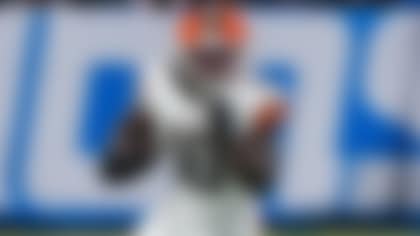ESPN The Magazine's Mina Kimes wrote an exceptional profile of Jalen Ramsey that included the following comments by the Jaguars cornerback on New England's Rob Gronkowski:
"I don't think Gronk's good." Registering my involuntary blinking, he course-corrects. "Let me say -- I don't think Gronk is as great as people think he is." Before the Patriots game, he explains, he had the Jaguars' analytics staffers pull some numbers for him. "Any time Gronk has been matched up with a corner, he's had a very bad game -- and that corner has had a very good game."
First of all, Jalen Ramsey asking the Jags' analytics team for information adds to the long list of reasons why he's one of my very favorite players. But let's dig into this, especially considering Gronk's newly revised contract.
Our Next Gen Stats team provided me with a rundown of Gronk's receptions over the past two seasons, broken down by who was covering him, and it seems to bolster Ramsey's point:
GRONK VS. SAFETIES/LINEBACKERS, 2016-17
Targets: 115
Receptions: 79
Receiving yards: 1,338
TD-INT: 9-0
Passer rating: 133.9
GRONK VS. CORNERBACKS, 2016-17
Targets: 24
Receptions: 11
Receiving yards: 192
TD-INT: 1-1
Passer rating: 70.1
A few things need to be unpacked here. First, cornerbacks are often thought of as better athletes than other pass defenders. In terms of what can be measured on the field over the past seven years, corners do clock in as faster runners, higher jumpers and are in a better position to disrupt intended passing targets than safeties and linebackers -- despite, on average, being slightly shorter in stature. The "in a better position" and height notes matter here: Gronk, at 6-foot-6, stands almost six inches taller than starting defensive backs (and about seven inches taller than starting cornerbacks specifically), and has certainly earned his reputation as a matchup nightmare. SEE: 56 career red-zone touchdowns on just 128 targets (43.8 percent). To compare, Travis Kelce is just 16 for 56 (28.6 percent) in this pursuit, while most top receivers check in between between 22 and 25 percent in this metric.
Given that we know defensive coordinators scheme specifically for Gronkowski, why have corners had more success? Is it because they are better athletes? This is where the "in a better position" comes into play.
Taking a deeper look into the actual defenses Gronk faced, I used computer vision to determine how far away defenders were from him. I measured three distances: the start of the play, when the pass was released and the end of the play. The goal here was to help diagnose either zone or man coverage. I tracked all plays where Gronk was either lined up in the slot or split out wide over the past three seasons -- he caught 105 balls on 299 targets (35.1 percent) in these circumstances. Then I split these plays into those where a safety or linebacker was in coverage and compared them to ones where he faced corners. The average distance at the time Brady released the ball was within 2 yards when Gronk faced safeties or linebackers. Gronk was able to garner twice as much separation versus corners. But remember: These are all plays where he lined up in the slot or split wide. When I looked at only plays when Gronk was the intended pass catcher in these formations, I saw that Brady's time to throw and air yards per target (11.7 yards vs. 13.3 yards) were lower when Gronk faced a linebacker or safety than a cornerback.
I then called two coaches who have specifically schemed to stop Gronk (multiple times) and asked them why this might be. The answer? When Gronk lines up outside, Brady and the Pats get an indicator of the defensive strategy. If a safety or linebacker is covering him, it's most likely man coverage. If it's a corner, the coverage is more likely to be zone -- and it's also likely that Brady's passing progression starts elsewhere, i.e., Gronk isn't his first read. This is a logical explanation for why the time to throw got longer and the results were less favorable. Think of it like this: When Gronk has been targeted against corners, it's been under more difficult circumstances.
Ramsey did say, "I don't think Gronk is as great as people think," so I went back and performed the same measurements for Travis Kelce and Greg Olsen (both stand 6-5). I don't know Ramsey's thoughts on them, but both are excellent tight ends by objective measures. Admittedly there are big differences in each of their quarterbacks and offensive schemes. However, the trend of longer time to pass for quarterbacks when their pass-catching tight end was facing a CB held. For Olsen, especially, the dip in passer rating was evident:
OLSEN VS. SAFETIES/LINEBACKERS, 2016-17
Targets: 117
Receptions: 69
Receiving yards: 975
TD-INT: 4-0
Passer rating: 97.4
OLSEN VS. CORNERBACKS, 2016-17
Targets: 39
Receptions: 20
Receiving yards: 199
TD-INT: 0-0
Passer rating: 66.2
What does this mean? Basically, that the situation for tight ends is different against cornerbacks than versus linebackers and safeties.
Ramsey isn't wrong to say Gronkowski's results against corners are statistically worse, but there's more to these numbers than it initially seems. Ramsey is fortunate to see the challenge of defending Gronk from the point of view of having an exceptional overall defense, and being a part of a scheme which allows for Ramsey's elite skills to be strategically (and in the case of last season, effectively) deployed against one of the greatest tight ends in NFL history.
Follow Cynthia Frelund on Twitter @cfrelund.












